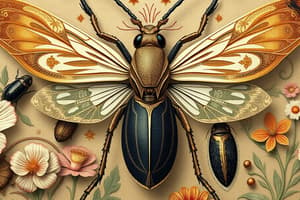Podcast
Questions and Answers
What is the general body structure of Phylum Porifera?
What is the general body structure of Phylum Porifera?
- Tissue-level organization
- Dependent on lungs for respiration
- Supported by needle-like spicules and protein (correct)
- Cellular level organization
Which reproductive strategy is common among most sponges?
Which reproductive strategy is common among most sponges?
- Oocyte and sperm fusion outside the body
- Monoecious/hermaphroditic (correct)
- Sexual reproduction through larval stage
- Asexual reproduction only
How do sponges obtain food and oxygen?
How do sponges obtain food and oxygen?
- By filtering water currents (correct)
- By consuming other animals
- Through photosynthesis
- Through direct absorption from the air
Which phylum includes animals that have a protective, nutritive environment for new individual development after fertilization?
Which phylum includes animals that have a protective, nutritive environment for new individual development after fertilization?
What is the main characteristic of Phylum Cnidaria?
What is the main characteristic of Phylum Cnidaria?
How do most sponges reproduce?
How do most sponges reproduce?
What is a key characteristic of the phylum Cnidaria?
What is a key characteristic of the phylum Cnidaria?
Which feature is unique to phylum Porifera?
Which feature is unique to phylum Porifera?
What distinguishes echinoderms from other organisms?
What distinguishes echinoderms from other organisms?
Why are phylum Platyhelminthes considered the simplest animals with bilateral symmetry?
Why are phylum Platyhelminthes considered the simplest animals with bilateral symmetry?
What is a common characteristic of organisms in the phylum Cnidaria?
What is a common characteristic of organisms in the phylum Cnidaria?
Which phylum exhibits primary radial symmetry and a gastrovascular cavity?
Which phylum exhibits primary radial symmetry and a gastrovascular cavity?
What is a characteristic feature of Subphylum Hexapoda?
What is a characteristic feature of Subphylum Hexapoda?
Which class of Echinodermata possesses pentaradial symmetry?
Which class of Echinodermata possesses pentaradial symmetry?
What is a distinguishing feature of Class Ophiuroidea: Brittle Stars within Echinoderms?
What is a distinguishing feature of Class Ophiuroidea: Brittle Stars within Echinoderms?
How are sea urchins characterized within Echinoderms?
How are sea urchins characterized within Echinoderms?
What is the main method of locomotion for Holothuroidea: Sea Cucumbers?
What is the main method of locomotion for Holothuroidea: Sea Cucumbers?
How many pairs of wings are usually present on the thorax of insects from Subphylum Hexapoda?
How many pairs of wings are usually present on the thorax of insects from Subphylum Hexapoda?
Study Notes
Subphylum Hexapoda
• Body with distinct head, thorax, and abdomen • Pair of antennae • Mouthparts modified for different food habits • Head formed from six fused segments • Thorax composed of three segments • Abdomen with variable number of segments (usually 11) • Typically six somites • Thorax with two pairs of wings and three pairs of jointed legs • Separate sexes
Phylum Echinodermata
• Endoskeleton of plates or ossicles • Water-vascular system • Radial or biradial symmetry • No head or brain, but with radial nerves • Endoskeleton of dermal calcareous ossicles • Locomotion by tube feet projecting from the ambulacral groove • Digestive system usually complete • Excretory organs absent • Sexes separate
Class Asteroidea: Sea Stars
• Pentaradial symmetry • Found along shorelines, on muddy and sandy bottoms, and among coral reefs
Class Ophiuroidea: Brittle Stars
• Largest group in terms of number of species • Possess five arms that are slender and sharply set off from their central discs • Five movable plates surround the mouth, serving as jaws • No anus
Class Echinoidea: Sea Urchins
• Compact body enclosed in an endoskeletal test • Lack arms
Class Holothuroidea: Sea Cucumbers
• Greatly elongated compared to other Echinoderms • Cephalization is absent • Tube feet are typically used for movement in species that crawl over the surface of the sea bottom • Hydrostatic skeleton
Phylum Cnidaria
• Characteristic stinging cells (cnidocytes) containing stingers (nematocyst) • Two basic types of individuals: polyps and medusae • Some are polymorphic (2 body plans during life cycle) • Exoskeleton or endoskeleton of chitinous, calcareous, or protein components in some
Phylum Platyhelminthes (Flatworms)
• Acoelomate (no body cavity) with organ-system level of organization • Simplest animals with bilateral symmetry • Triploblastic (three germ layers) • Cephalization • Nervous system with a pair of anterior ganglia with longitudinal nerve cords • Simple sense organs
Phylum Porifera (Sponges)
• Simplest multicellular invertebrates • Body is an assemblage of cells embedded in a gelatinous matrix and supported by needle-like spicules and protein • Sessile (adult) or motile (larva) animals • Depend on water currents to bring them food and oxygen and to carry away their body waste • Types of cells and extracellular matrix consisting of a collagen-like gel with suspended cells that perform various functions • Types of canal system • Most sponges are monoecious/hermaphroditic (have both male and female sex cells in one individual) • Capable of sexual and asexual reproduction • Oocyte retained; sperm ejected
Studying That Suits You
Use AI to generate personalized quizzes and flashcards to suit your learning preferences.
Description
Test your knowledge of the characteristics of the Insecta class, including body segments, antennae, mouthparts, and wings. Learn about the distinct features of insects and their classification within the Hexapoda subphylum.




